VIA Usage Guide
VIA Configurator is a desktop app that talks to your VIA-enabled keyboard and allows you to remap keys on-the-fly, as well as toggling layout options, programming macros, and controlling lighting.

For info on how VIA relates to the underlying QMK Firmware, see this for more details: VIA and QMK Firmware
Is my keyboard supported by VIA?
Here's a list of keyboards with VIA support: Supported Keyboards. Note that just because your keyboard is listed there doesn't mean that you can immediately use VIA Configurator with it. The firmware flashed to the keyboard must have VIA support enabled, and you can find pre-compiled .hex/.bin firmware files with VIA support here: VIA Firmware Downloads.
Getting VIA
The VIA app now comes in two flavors:
- Web App (Preferred)
- With the web app, you don't have to do any updates on your end when new features are released. However, you are limited to Chrome-based browsers that support WebHID. (Sorry Firefox users)
- To launch the web app for VIA, go to this site Keebio - VIA Web App.
- Note: The link above is for a version of the VIA app hosted by us with additional support for Keebio boards. For the original VIA app, go here: VIA Configurator.
- Desktop App
- With the desktop app, since it is a wrapper for the web app, it will still need an internet connection to work, but it can be a little bit more reliable with detecting your keyboard
- To download the VIA Configurator app, you can go to the releases page here: VIA Releases. The app is available for Windows, macOS, and Linux.
Launch VIA
Desktop App
When you first launch the desktop app for VIA, you will see this screen:
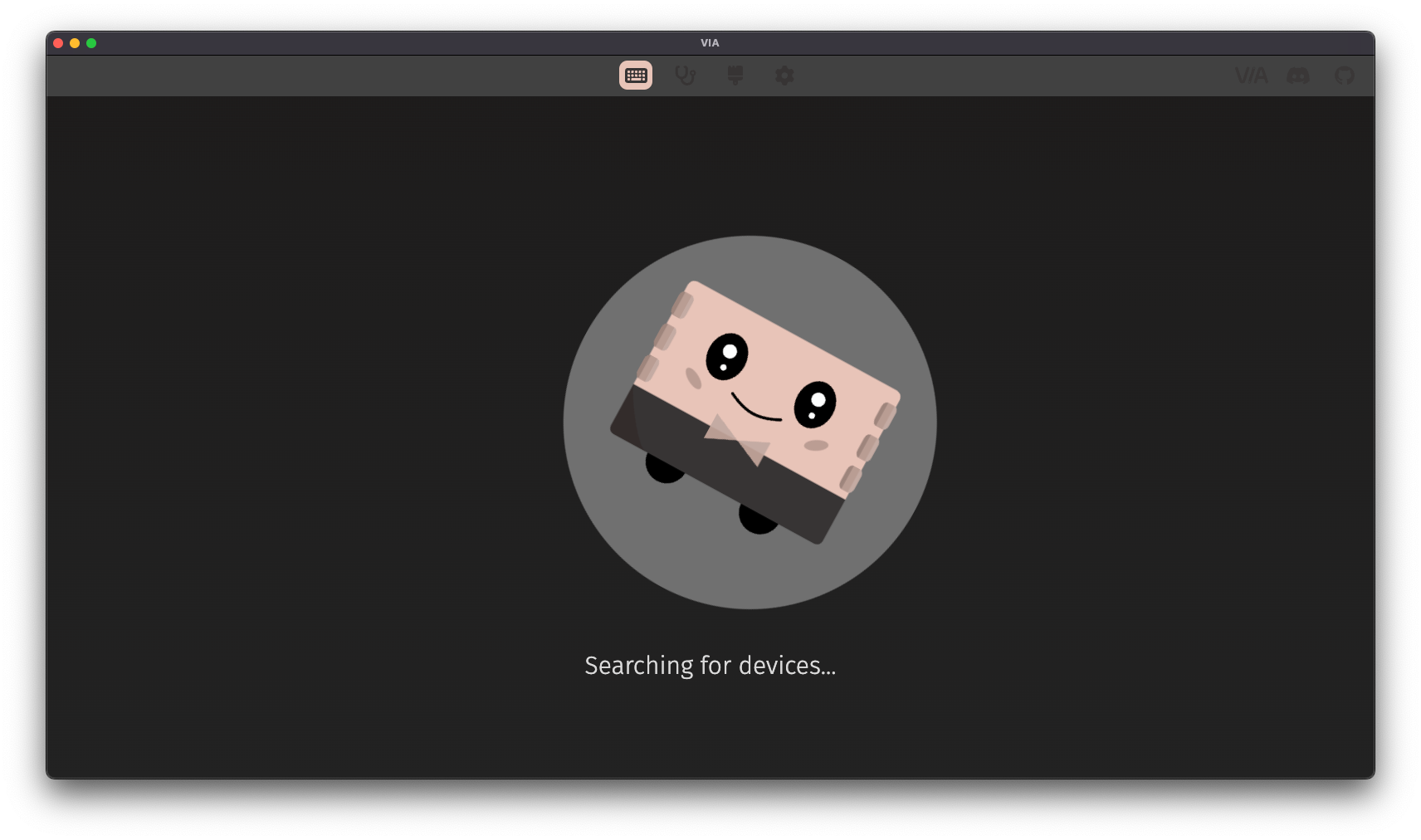
It is recommended that after you open VIA to plug in your keyboard.
Web App
To launch the web app for VIA, go to this site Keebio - VIA Web App.
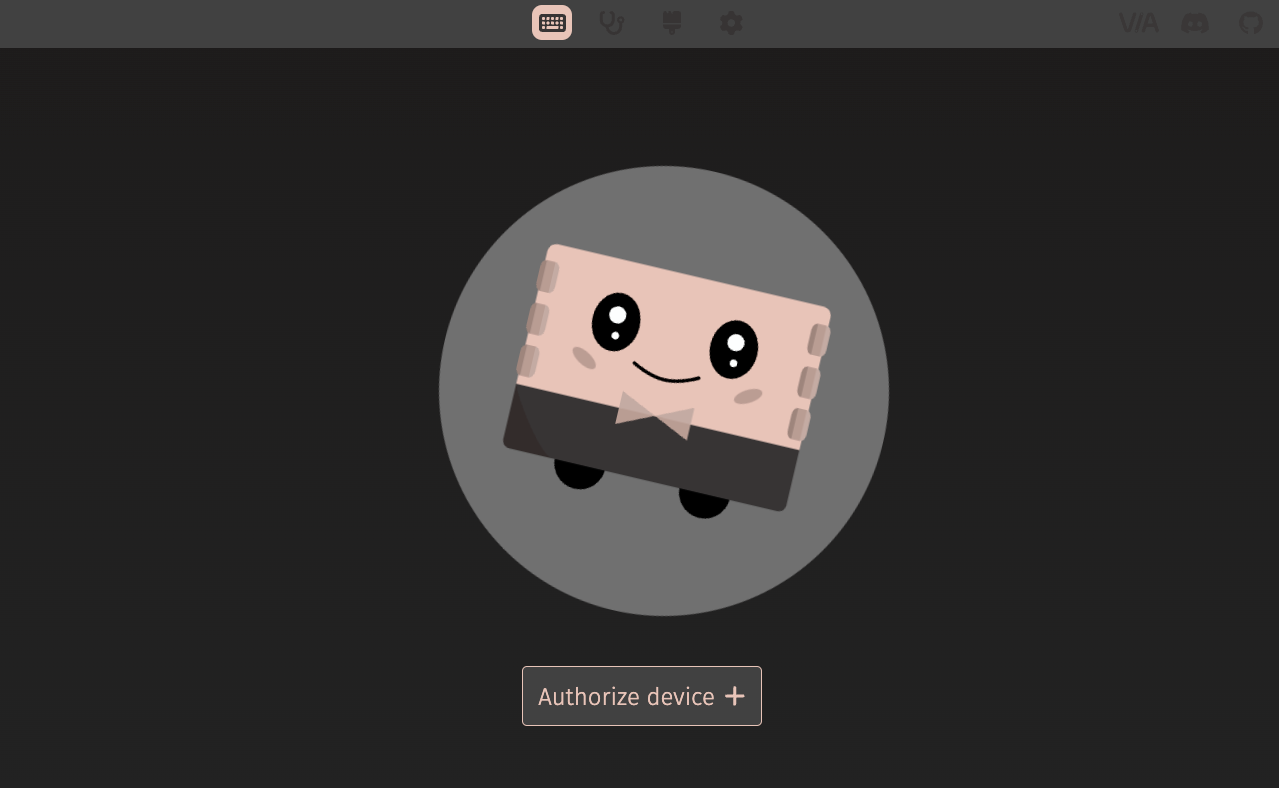
Next, you will need to give your web browser permission to connect to your keyboard, so click on Authorize device +. This will bring up a prompt to allow you select your keyboard.
Select your keyboard and click Connect.

Connected to Keyboard
Once you are connected your keyboard, you should see your keymap like below:

If your keyboard does not load, then check again that the firmware flashed to your board has VIA support enabled.
If you're using the desktop app, try plugging your keyboard in prior to launching VIA if you are having issues.
You'll want to be on the Configure tab (at the top) to verify a few things before testing your keys.
Tabs
There are 3-4 tab icons at the top, allowing you to switch between different tools.
![]()
Configure Tab
At the top left, you'll see some options available to choose from:
- Keymap - Edit your keymap
- Layouts - Adjust layout options
- Macros - Specify what a macro outputs
- Lighting - Control backlighting and RGB underglow if available
- Save + Load - Backup your layout to a file on your computer
Keymap
The Configure tabs shows your keymap, and you can select different layers to edit. The main layer is 0.
You can click on a layer to edit it and select the key on your keyboard you want to change. There are various groups of keycodes at the lower left that you can set each key to:
- Basic
- Media
- Macro
- Layers
- Special
- QMK Lighting
Basic
These are your basic keycodes, like letters, numbers, symbols, arrow, and modifiers.
The first two squares in the selection area are:
KC_NO(Empty): Nothing is sentKC_TRNS(Upside Triangle): Pass-through, meaning whatever is mapped to that key on the next lower layer is sent
If you are a macOS user, Win/GUI is equivalent to Cmd/Command, while Alt is equivalent to Opt/Option.
Media
If you're looking for volume and music/movie oriented controls, this section has you covered!
Macro
You have 16 macro keys to do with what you will! Select a layer, then a key above and then select what macro you'd like to apply.
See the Macros section to configure the macro.
Layers/FN
If you hover over a layer option, VIA will give you a brief bit of information about what it does. For more in-depth knowledge about what a layer is and how to use them, see A Primer on Layers.
Layers are numbered starting from 0, where 0 is your main layer that is normally accessible without doing anything special.
Some terms to know about turning layers on and off:
MO(layer)
Most commonly used layer keycode, as this is basically the equivalent to an Fn key. This momentarily activates the desired layer while you are holding down the key. Once released, the keyboard goes back to its original layer.
TG(layer)
Toggles a layer on and off. Similar to Num Lock.
DF(layer)
This turns on and off your base layer. Most folks usually have their alphas, but if you're reserving your keyboard for gaming, you can use this to maintain a custom game layer to remain active. Game on, friends!
TO(layer)
This turns on one layer. BUT! Be aware this doesn't toggle back, so you need to program a key on this layer to get yourself back. Or be stuck in Kansas. Your choice.
OSL(layer)
This temporarily activates a layer until you press the next key. OSL, standing for "one-shot layer". This is generally if you want to do one thing and then jump back to what you were doing before without having to hold down the layer key.
TT(layer)
Smush MO and TG together and you get this. holding a key down activates the layer and it releases the layer as the key does. You can configure how many times it needs to be pressed to turn the layer on or off.
Special
In this section you can enable language changes as well as operations that usually take a combination of two keys or more and apply it to one key for easy use. Other keycodes here include mousekeys, F13-F24, and symbols.
The last entry here is the Any key, which allows you to specify a QMK Keycode if one is not listed in any of the groups.
How to use Any key
The Any key can be used to do some more complex keycodes, like ones involving modifiers, layers, or mod-tap keys. You can also just put in a normal keycode here if you'd like.
Not all aliases are supported, for example LCTL_T(kc) can't be used, so MT(MOD_LCTL, kc) would have to be used instead.
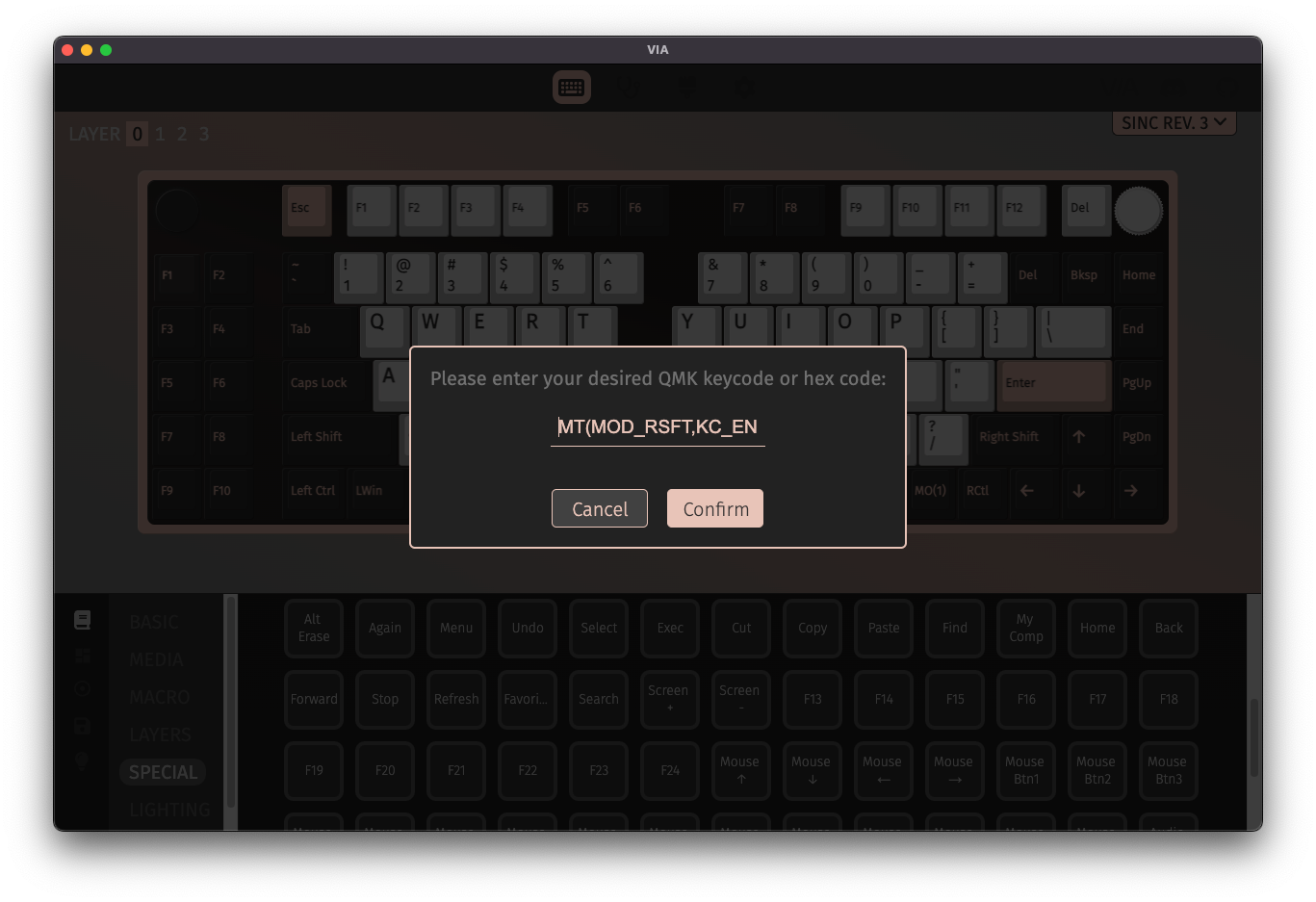
Here's some examples:
LALT(KC_TAB)- Sends Alt-TabLCTL(KC_C)- Sends Ctrl-CLGUI(KC_C)- Sends Cmd-C or Win-CLSFT(LCTL(KC_END))- Sends Shift-Ctrl-EndMO(1)- Momentarily turn on layer 1LCA(KC_DEL)- Sends Ctrl-Alt-DelMT(MOD_RSFT, KC_ENT)- Sends Shift if held, Enter if tapped
QMK Lighting
This series of operations enable you to give your keyboard changes to the lighting on-the-fly for future use without needing to plugin to VIA. Shortcuts? Yes, please.
BL stands for Backlight (typically single-color LEDs for each key).
Encoders
New in Version 3 of VIA is the ability to reprogram encoders. Note however, that the firmware and VIA keyboard definition JSON must be set up to allow for the encoders to be remapped using VIA.
If your keyboard does support remapping of encoders in VIA, on the keymap, the encoder will be displayed as a dashed circle with nothing inside of it as shown below.
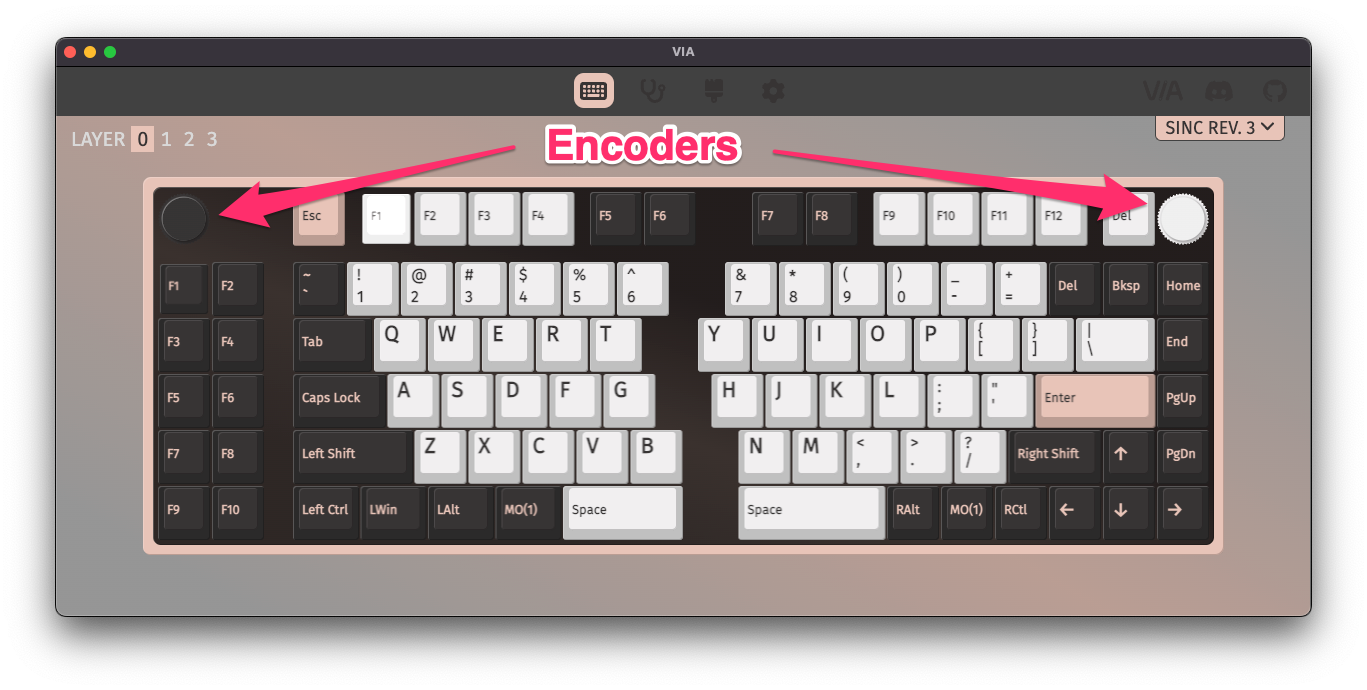
To edit the mapping of the encoder, click on it, and the bottom half of the window will show the mappings for clockwise and counter-clockwise rotation, as well as pressing the encoder (if the encoder can be pressed).

Where is FN?
An Fn key is just a reduced version of layers where you only have 1 layer accessible to you. The equivalent to Fn is MO(1), which is in the Layers area of keycodes. By setting a key to do MO(1), you are telling the keyboard to go to Layer 1 (remember that the main layer is 0), so you can access additional keys on that layer.
Layouts
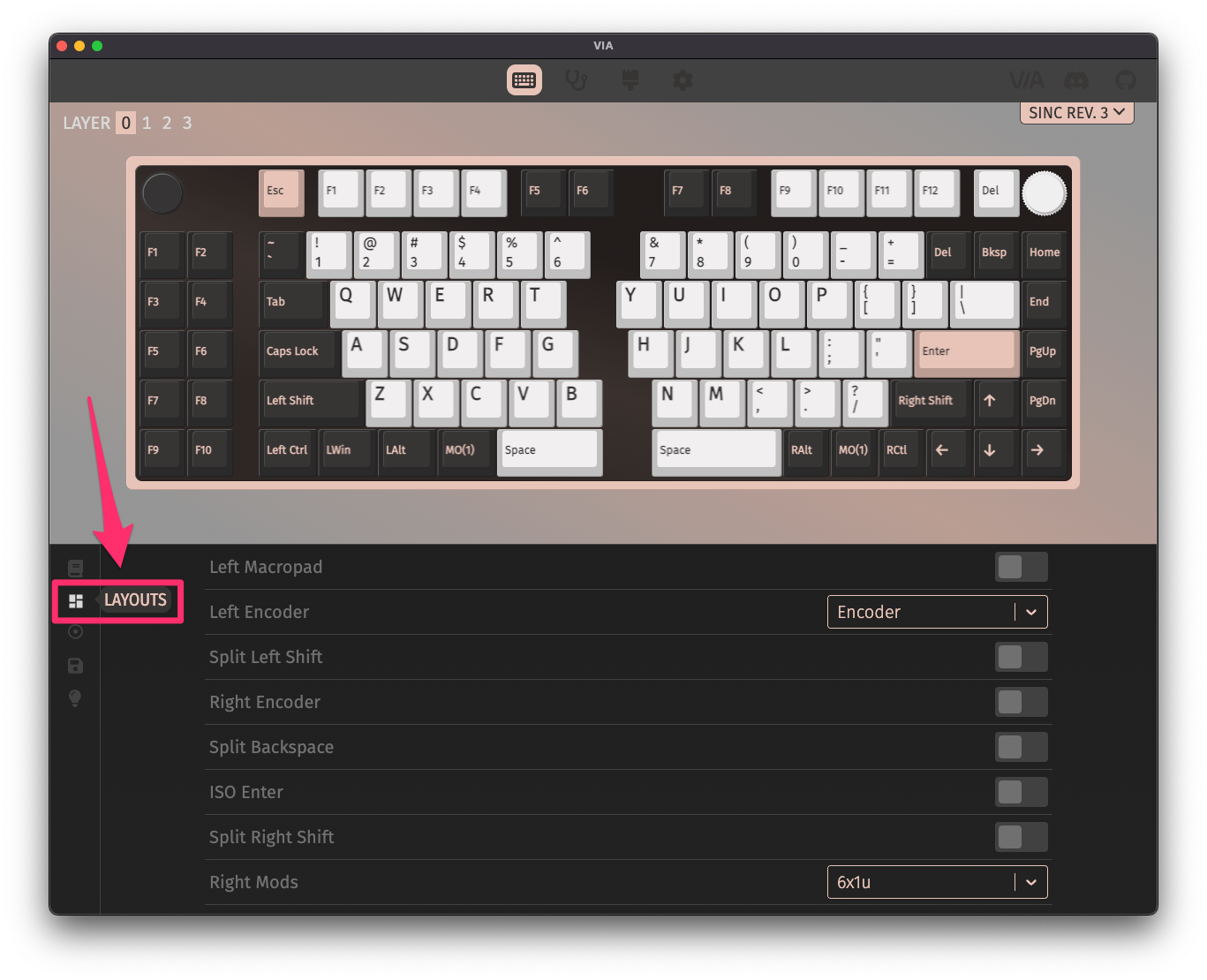
Once selected, the screen below the keyboard will allow you to change what your shift keys, left/right bottom row, backspace (split vs 2u) and enter key (ISO/ANSI) look like.
You can verify if all your settings saved by clicking on the Key Tester tab at the top.
Macro
If you've added a macro keycode to your keymap, you can program the macro here.
For example, you can program a macro to type out text for you. Not recommended to do this with passwords, albeit that is absolutely possible.
There are two ways to configure a macro:
- Macro Recorder
- Keycode Entry
Macro Recorder

This method allows you to record a macro, instead of trying to type in keycodes manually.
Keycode Entry
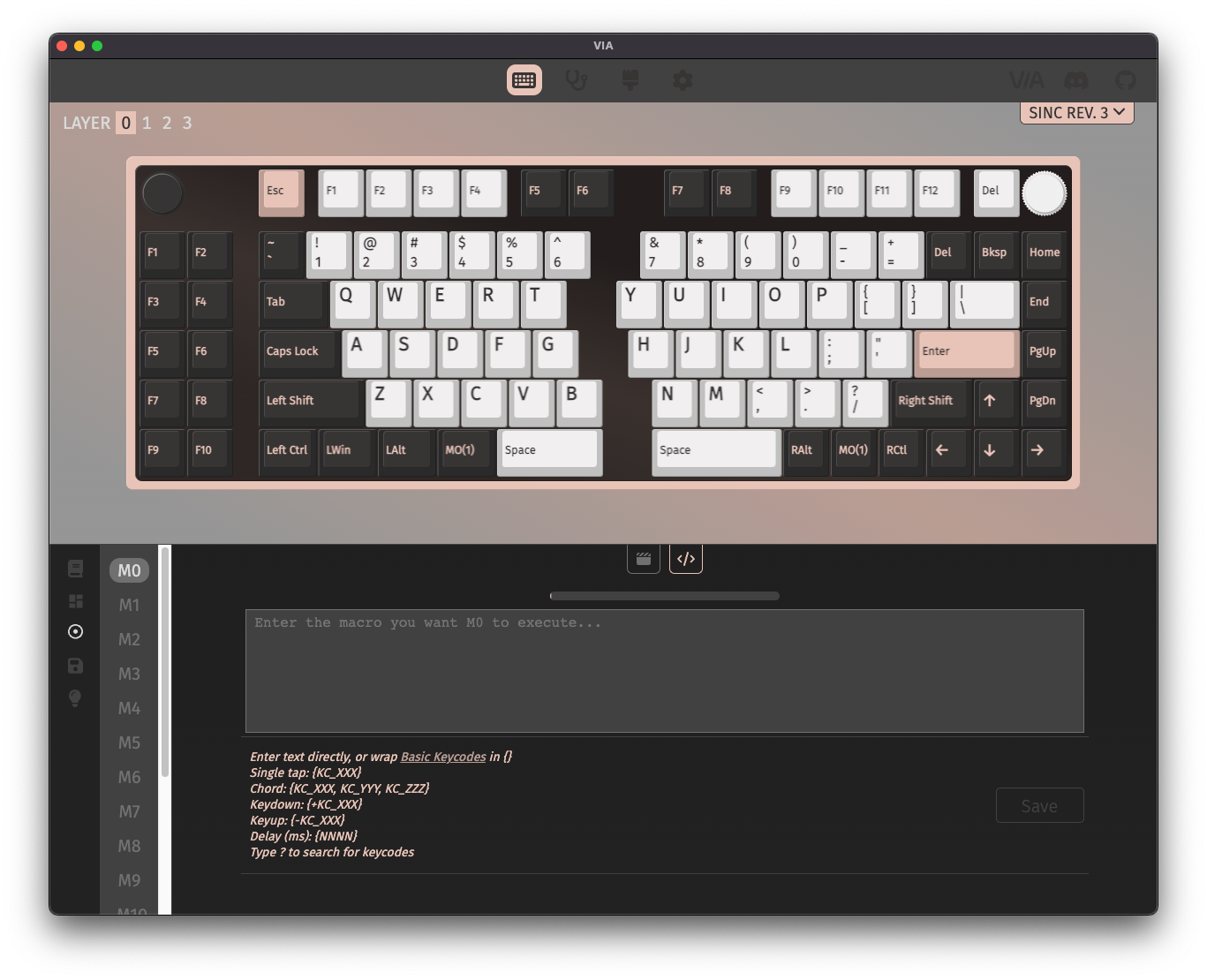
You can either type text directly without having to know anything about QMK keycode names, or if your put stuff in curly brackets ({}), you can use basic QMK keycodes.
Some terms to know
MO(layer): This activates the layer when held down and you come back to your prior layer when you release the key. Similar to Shift and Fn keys in operation.
LM(layer, modifier): This activates a layer and will also maintain a modifier for you while pressed.
LT(layer, keycode): Press this and hold to activate a layer and send the keycode when tapped briefly. Best use for keys you usually only press quickly like Tab or Space.
Example Macros
MyPassw0rd!- SendsMyPassw0rd!{KC_A,KC_C,KC_E}- Sendsace{KC_LCTL,KC_C}- Sends Ctrl-C
Lighting
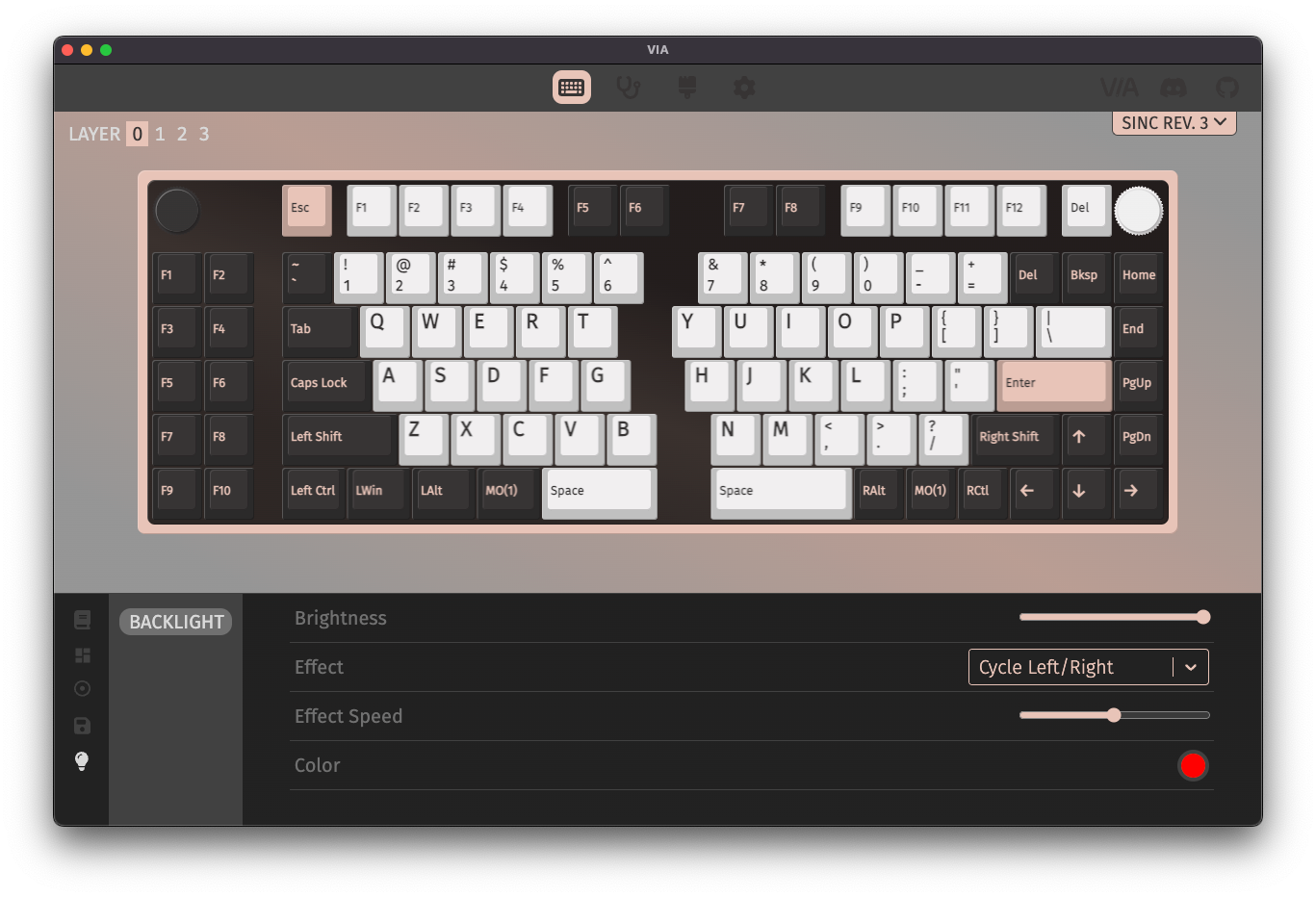
Depending on your board, not all of the options below will be availablee.
Brightness
Want to blind yourself? Or have a soft whisper of light? You have both of those choices and more here!
Effect
Want special flickers and jazz? Turn it on if you do!
Underglow Brightness
All the lights under the keyboard are controlled here.
Underglow Effect
With many options, you can choose how wild or tame you want to get with your pizzazz lighting. Some keyboards has reactive RGB effect enabled, which mean the effect is based on which key you press.
Below is a video demonstrating most of the effects available.
Underglow Effect Speed
Make it zippy! Or sleepy. Choice is yours!
Underglow color
Not feeling that shimmery? Just pick the one color you want here!
Key Tester Tab
After getting your setting where you want them, it's good to test if all your keys are operating properly.
You can see Testing Your PCB for more details.
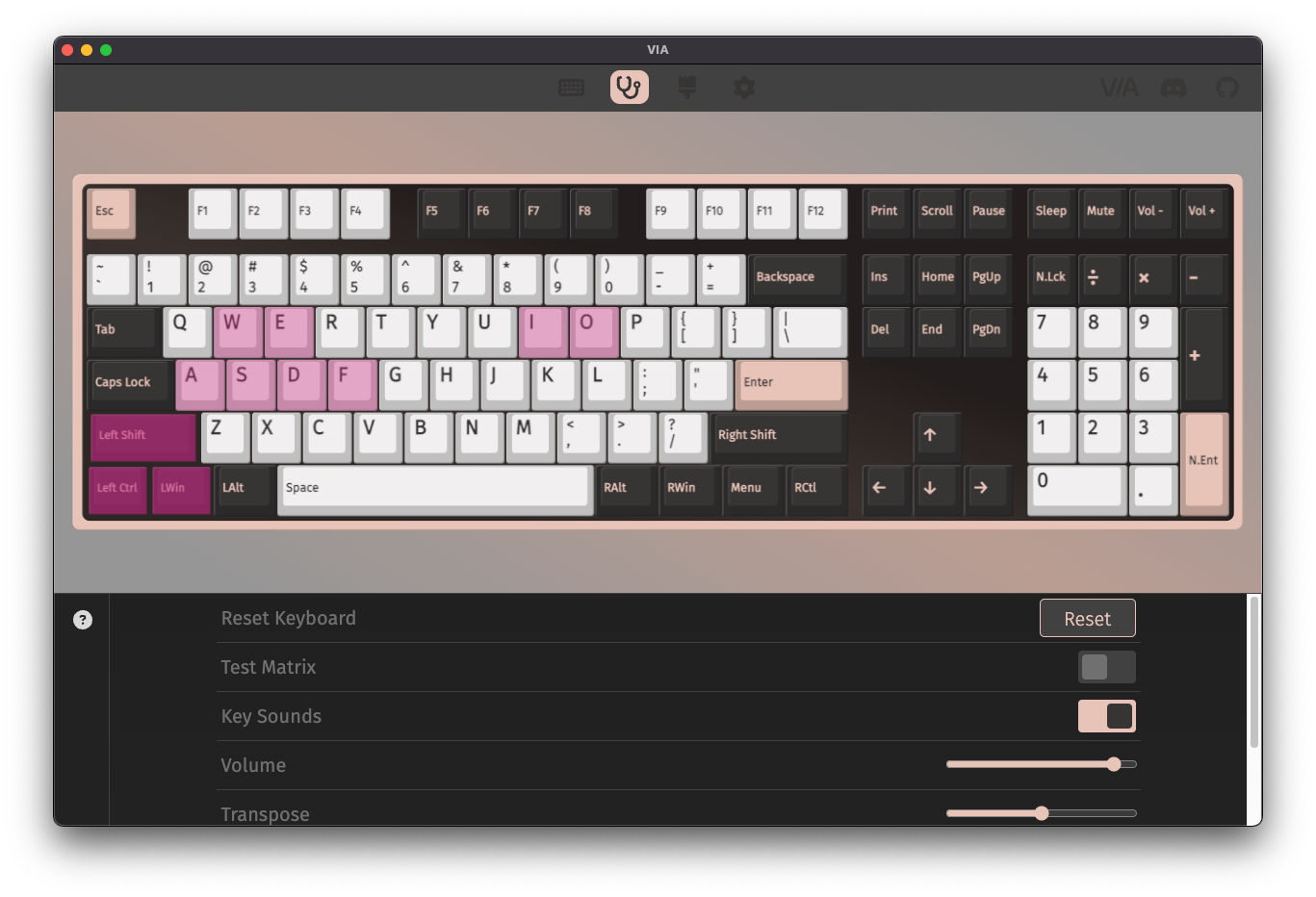
For special keys, like layer keys that aren't on a normal keyboard, you can switch to matrix mode by selecting Test Matrix. This will let you see if all of the physical locations of keys work.
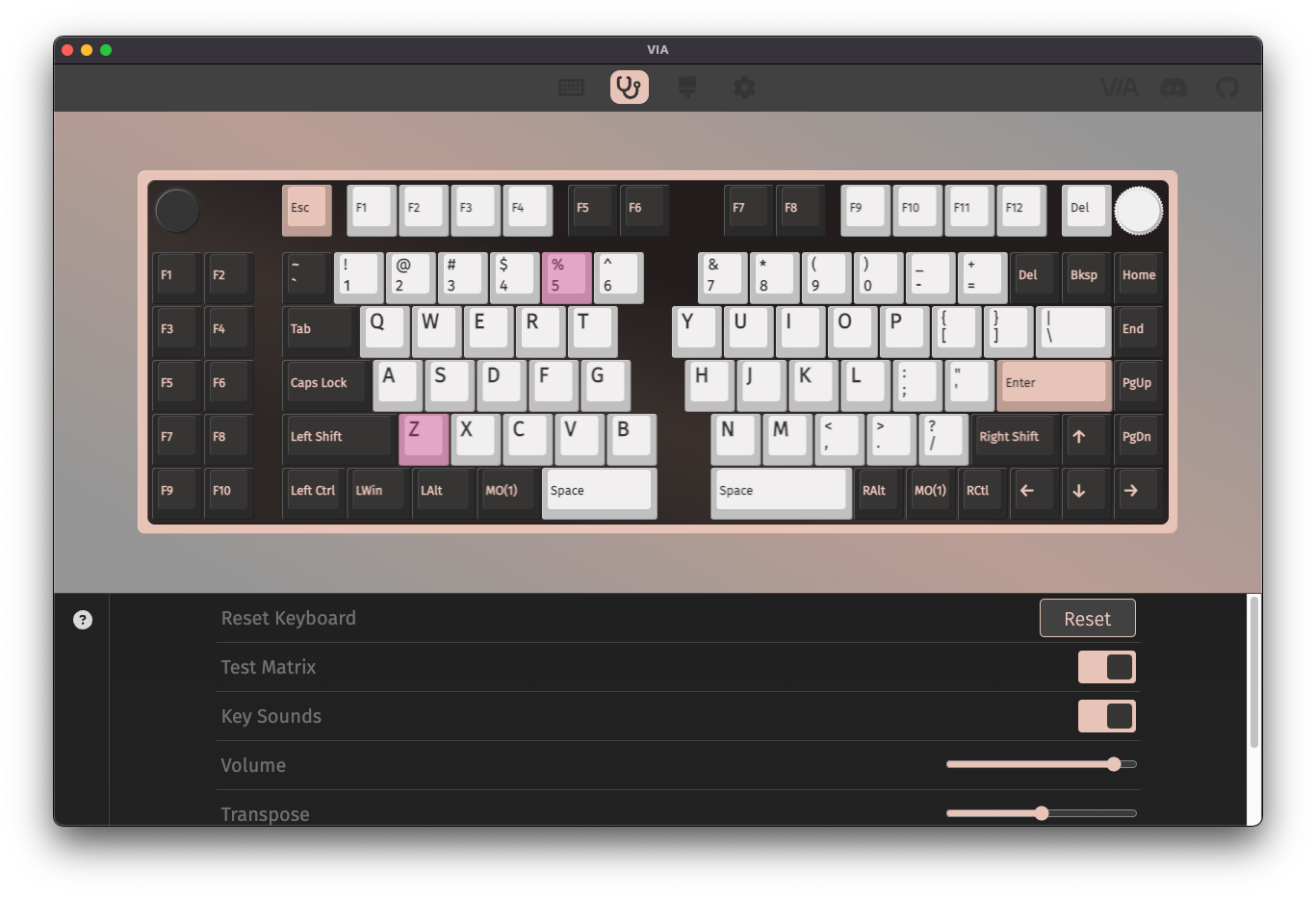
Design Tab
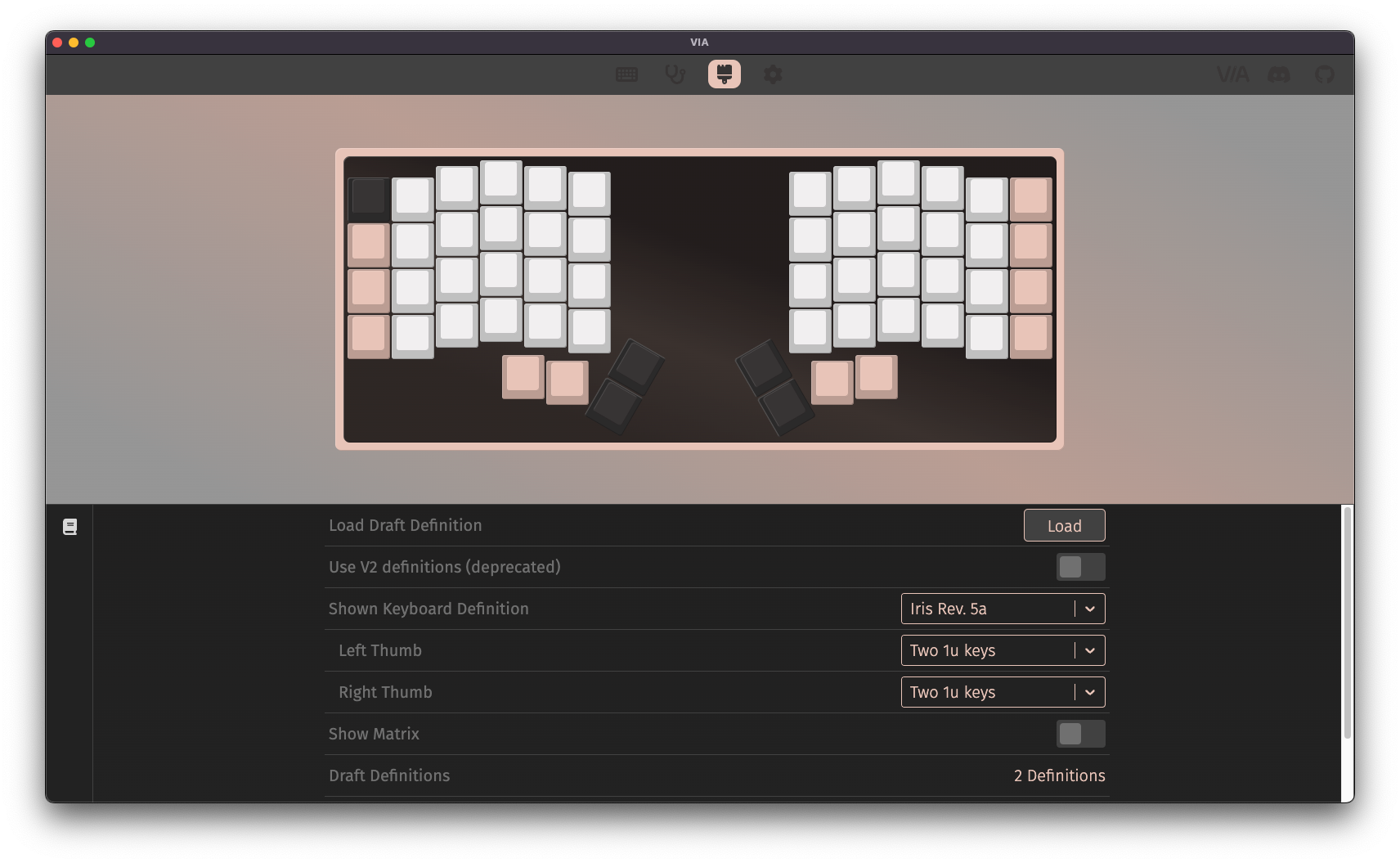
If you are developing your own keyboard and adding in VIA support, you'll need to enable the Design Tab.
Sideloading VIA Definition Files
In the Design tab, you can load in various draft definition files to check that your keyboard loads in properly.
Sometimes, some not so great keyboard vendors don't work with the VIA team on getting their definition files added to the app, so they'll make you download definition files and manually load them here. Another reason could be that preliminary VIA support has been added to a board for testing, and the designer is awaiting for QMK and/or VIA to merge in the PR for it.
Click on the Load button to the right of Load Draft Definition and select the .json file given to you. This should not be the info.json file from the QMK repository, as that is not compatible with VIA since it is not a VIA keyboard definition file. Once loaded, VIA should be able to detect your keyboard, if you've flashed VIA-enabled firmware to it.
VIA should remember the draft definition file that you loaded into it the next time you launch the app, so you won't have to load it again.
Settings Tab
You generally won't need to use this tab unless needing to do some workarounds.
- Show Design tab - Enables the Design tab, so you can load in custom keyboard definitions that haven't been merged into VIA yet
- Fast Key Mapping - If enabled, when you remap a key, the key selection box to remap automatically moves to the next key
The rest of the options allow you to change the look of the app.